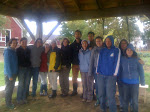In my post yesterday, I promised to share interesting sights and facts regarding farm manure--particularly the waste made by your food animals. Today is a slight detour--horse poop. I suppose you could eat a horse but the lovely Belgians living at Maggie's farm are here for work. They can be harnessed and driven to plow or harrow the fields, pull loads or happy farmer-trainnees on a wagon. April and Ruby--seen in the photo at the right--are beautiful members of our farm community and produce their fair share of manure, which is composted and spread on the fields.
 |
| Horse manure |
 |
| The Harrow (about five feet wide) |
One of our chores is to clean their fenced paddock. They make it easy for the poop-scooper by leaving their droppings in two general areas. One pile is in the southwest quadrant of the paddock and the other is in the northeast quadrant. I didn't think much of it until a couple of weeks ago, when they were walked out to a temporary paddock for some quality pasture. In this rectangular paddock, one could have drawn a diagonal line from corner to corner and there sat the horse apples, a pile in the southwest corner and a pile in the northeast corner. Directions aren't as important as that diagonal line. And once horses choose a potty-place, they will avoid eating in this area. Soon the grass will grow high, brambles will sprout up and shade out the good pasture. In order to keep the pasture clear of these "zones of repugnance" --where droppings are left and that new grass is avoided, the fields are "harrowed" which means to drag a wire-y implement over the field and it shakes up and breaks up everything and spreads the manure around. Then there won't be a "zone of repugnancy," the grass will grow back evenly across the field and the horses can pick fresh corners, if they like!

Our outing today was to the Harvard Forest to learn about woodlot management. The science and art of woodlot management is to support a healthy forest alongside one's farm in order to have fuel, building materials, wild life buffer, maple syrup and all the other good things that forests bring to our lives. The Fisher Museum displays some exquisitely designed dioramas that show the history of central Massachusetts in terms of land use. If you are in the area, I highly recommend a visit.
In the afternoon, we reviewed our tree identification projects and then began working on our crop rotation project. This evening, Nora and I worked on our goat fencing project.
Tomorrow: Group A goes to Chainsaw School and Group B goes to horse-driving school.





No comments:
Post a Comment